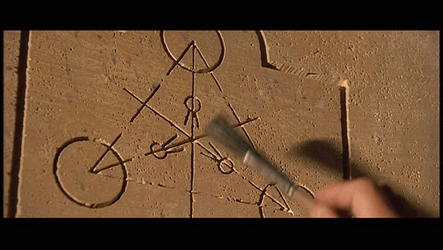Arch 443/646:
Architecture and Film
Getting Started in Final Cut Pro/Express

Arch 443/646:
|
 |
last updated Friday, January 11, 2013 1:49 PM
1. Preparing yourself and your files: If you are using any image files or audio files, make sure that your images are at 72dpi and at least as large as the standard video size of 640x480 pixels in JPEG format. If they are any smaller than that, they will be blurry. You can easily use larger images, but not "huge". If you bring a PSD (layered) file into FCP and drop it on the timeline, it (should) break out into its layers, so that you can manipulate the image layer by layer. Put all of your images in a file folder. You need to IMPORT these into FCP using the IMPORT command. If you drag and drop them in from your desktop, and then move the folder, the images will disappear from your movie because they have been "disconnected". |
2. Preparing your Audio Files: Final Cut Pro is fairly picky about what sort of audio files you use. They have to be at 48kHz. Standard CD files are in m4A format and recorded at 44.1kHz. You need to convert these with Quicktime Pro to AIF files at 48kHz to prevent potential popping noises in the final video. FCP does not like MP3 or AAC files. These MAY be converted to AIF format in Quicktime Pro, but the audio quality will not be as good as if you use an actual song from a real audio CD. You cannot use music directly from iTunes. You can convert files (follow instructions at link above) EXCEPT for songs that you have purchased from the iTunes store. (This is NOT true for iMovie which is designed TO use music from iTunes...) |
3. Video Files: FCP prefers film that has been shot with 16-bit audio. Check your camcorder settings as some default to 12-bit audio and this can cause problems. Problems like the audio and video not being in sync in your final product. FCP can use the "timecode" of a tape by which to import the video. As stopping and starting the tape can put little blanks in the timecode, it is preferable to run the entire tape first (cap on so it is black) to time stamp it, then rewind it and start shooting. If the colour and lighting in the original video is poor, it will be poor in the final movie. You really cannot correct for poor light with special effects. Insufficient light to shoot usually results in grainy film with poor colour. DO NOT SIMPLY TRANSFER YOUR ENTIRE TAPE ONTO THE COMPUTER FOR EDITING. The more excess tape you load into the program, the longer it will take to sort through and find the bits you want to use. DO start/stop the tape when you are filming. There is a way in FCP when you import the tape to have it "Mark" the spots where you started/stopped the tape. This way you can find the pieces more easily. If you just let it run for an hour, it is difficult to find what you are looking for. |
4. Issues with Transitions: FCP is a bit tricky when applying transitions to movie clips. It does not ASSUME that it is OK to just "use" some of the movie to create the transition. Transitions "eat" some of the clip. Here is a tutorial on how to use the Ripple Tool to create the transition: http://www.fcpbook.com/Effects1.html |
5. Exporting your file as a Movie: There are different ways of creating the exported film. Video files are HUGE. If you try to play a RAW file from an external drive it will likely be jerky. To play on a DVD that you use in a DVD player, the files are compressed (at about a 6:1 ratio) in order to fit on a DVD (capacity of 4.7GB, single sided). You can use FCP to iDVD or Premiere to Adobe Encore to achieve this. If you don't have Encore, you can export a RAW file from Premiere and import that into iDVD. If you're using Final Cut Pro, select: File ... Export ... Using QuickTime Conversion (If you select the export option labeled simply "QuickTime" will cause an uncompressed QuickTime to be exported -- far too large to be used online -- but very good for archiving as it is "full quality" and you can always make is smaller later to upload it to YouTube or something). You'll then get a Save dialog box. Choose a location for your movie, probably on your scratch disk, and specify a filename for the exported movie file. At this point, you have three options:
|
FONT ISSUES: Some students have had issues with their font pixellating in the final DVD. When employing font, please be sure that it is large enough to read on the screen. This suggestion after days of toil on their film with fuzzy font: ....So, here are the 2 steps that finally worked for getting the font to be clear in FinalCut Pro. - I used the same font that was used in the ‘sample text’ screen when you first add the effect, and made sure all of it was at least size 20 pt - We tried so many different codecs for exporting our film, and this is the one that finally worked: export as quicktime pro conversion, then select DV stream in the drop down menu, then select DVPro50 (I think that’s what it’s called) and the settings are automatically selected for you. The font will appear fuzzy on the computer screen when you play the .dv, but it will clear up when you get it on to a DVD. Holly and Suzanne Also, Golzar found this helpful site with an alternate solution. This one actually seems to suggest NOT exporting as .DV, but suggests other possibilities. http://www.geniusdv.com/weblog/archives/quality_of_text_in_final_cut_pro.php |